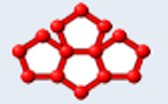Simbiosys
From Wikipedia, the free encyclopedia
Not to be confused with Symbiosis.
 | |
| Type | Private |
|---|---|
| Industry | Life Sciences |
| Founded | 2001 |
| Headquarters | Toronto, Ontario, Canada |
| Key people | Zsolt Zsoldos, Chief Technology Officer |
| Website | www.simbiosys.com |
SimBioSys (short for Simulated Biomolecular Systems) is a Toronto based chemistry software company focusing on structure based drug discovery and retrosynthetic analysis tools. It has established a strong reputation as one of the leading developers of flexible docking applications, virtual screening methods and computer aided organic synthesis design.
Areas of Expertise
Founded by a group of computer scientists and chemists, SimBioSys combines sophisticated search algorithms, machine learning techniques and informatics approaches with chemical knowledge and modelling.
Products
- eHiTS [1] - A fragment based flexible docking software. eHiTS uses an exhaustive and systematic search algorithm that is designed to find the global minimum energy pose of ligands in proteins' binding pockets. The application uses SimBioSys' proprietary scoring function.[2] In 2008 the company ported its docking software to Sony's PlayStation 3 and other Cell Broadband Engine platforms to achieve higher screening speeds. That created huge interest especially with researchers using PlayStation 3 cluster technology.
- LASSO [3] - A similarity based virtual screening tool that uses elements of eHiTS scoring function to identify bioactive molecules in large libraries of compounds.
- ARChem [4] - A retrosynthetic analysis tool that searches for possible synthetic routes from commercially available starting materials to target molecules.
- CheVi - SimBioSys' 3D molecular visualization software.
Partnerships
SimBioSys maintains marketing partnership with KeyModule. It distributes the UK based company's lead design tool, SPROUT, as well as other products.
See also
- Molecular docking
- Scoring functions
- Virtual screening
- Drug design
- Retrosynthetic analysis
- Cell microprocessor
References
- Results of Merck's comparative enrichment study for molecular docking software
- ↑ Zsolt Zsoldos et al.: "eHiTS: A new fast, exhaustive flexible ligand docking system" Journal of Molecular Graphics and Modelling; Volume 26, Issue 1, July 2007, Pages 198-212; Available online 17 June 2006. http://dx.doi.org/10.1016/j.jmgm.2006.06.002
- ↑ Pablo Englebienne and Nicolas Moitessier: Docking Ligands into Flexible and Solvated Macromolecules. 4. Are Popular Scoring Functions Accurate for this Class of Proteins?, Journal of Chemical Information and Modelling (ACS JCIM), Publication Date (Web): May 15, 2009 (Article) doi:10.1021/ci8004308 http://pubs.acs.org/doi/abs/10.1021/ci8004308
- ↑ Darryl Reid et al.: "LASSO - ligand activity by surface similarity order: a new tool for ligand based virtual screening " Journal of Computer-Aided Molecular Design, Published online: 18 January 2008, http://dx.doi.org/10.1007/s10822-007-9164-5
- ↑ James Law et.al:"Route Designer: A Retrosynthetic Analysis Tool Utilizing Automated Retrosynthetic Rule Generation", Journal of Chemical Information and Modelling (ACS JCIM) Publication Date (Web): February 6, 2009; doi:10.1021/ci800228y , http://pubs.acs.org/doi/abs/10.1021/ci800228y
External links
- SimBioSys official site
- SimBioSys-Blog official blog site
- ARChem Route Designer presentation presentation on ARChem by Antony Williams
- Free Virtual Screening Service on ChemSpider; LASSO virtual screening was integrated with ChemSpider compounds allowing free screening against 40 different targets (or protein families) that are part of the DUD virtual screening dataset.
This article is issued from Wikipedia. The text is available under the Creative Commons Attribution/Share Alike; additional terms may apply for the media files.